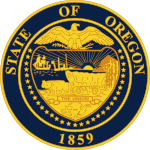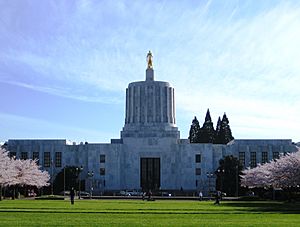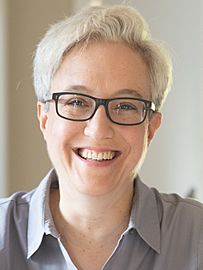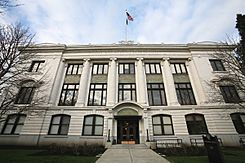Government of Oregon facts for kids

|
|
| Polity type | Sub-national administrative division (federated state) |
|---|---|
| Part of | United States of America |
| Constitution | Constitution of Oregon |
| Legislative branch | |
| Name | Legislature |
| Type | Bicameral |
| Meeting place | Oregon State Capitol |
| Upper house | |
| Name | Senate |
| Presiding officer | Rob Wagner, President |
| Lower house | |
| Name | House of Representatives |
| Presiding officer | Julie Fahey, Speaker |
| Executive branch | |
| Head of State and Government | |
| Title | Governor |
| Currently | Tina Kotek |
| Appointer | Election |
| Cabinet | |
| Leader | Governor |
| Headquarters | Oregon State Capitol |
| Judicial branch | |
| Name | Judiciary of Oregon |
| Chief Justice | Martha Lee Walters |
| Courts | Courts of Oregon |
| Supreme Court of Oregon | |
| Chief judge | Martha Lee Walters |
| Seat | Supreme Court Building, Salem |
The government of Oregon helps run the U.S. state of Oregon. It is set up by the Oregon Constitution. This government has three main parts, called branches: the executive, the legislative, and the judicial. They work together, much like the federal government of the United States does.
Oregon also uses a system of special groups called commissions. These groups are made of everyday citizens. The governor chooses them, and the Senate must agree. These commissions help manage state agencies. They can hire or fire agency leaders. They also approve important changes to agency rules.
Contents
What is the Oregon Constitution?
In 1857, leaders from the Oregon Territory met. They wrote the first constitution for Oregon. On November 9, 1857, people in Oregon voted to approve it. This constitution became official when Oregon became a state on February 14, 1859.
The constitution stayed the same for many years. But since 1902, it has been changed many times. These changes often happen through a system called direct legislation. This lets people vote directly on new laws or changes to the constitution.
The current constitution has 18 sections. It starts with a bill of rights. This part lists many rights and freedoms for people in Oregon. These are similar to the rights in the United States Bill of Rights. The rest of the constitution explains how the state government works. It also talks about elections, the state capitol, and Oregon's borders.
Who is in the Executive Branch?
- Elected Executive Officers of Oregon
The executive branch is in charge of carrying out the laws. The main leader of this branch is the Governor of Oregon. The governor is like the state's chief executive officer.
Other important elected officials in this branch include:
- The Oregon Secretary of State: This person is in charge of elections and keeps state records. They also chair the Oregon Sustainability Board.
- The Oregon State Treasurer: This person manages the state's money.
- The Oregon Attorney General: This person is the state's top lawyer. They lead the Oregon Department of Justice.
- The Oregon Commissioner of Labor and Industries: This person works to protect workers' rights.
Some state agencies are also part of the executive branch. For example, the Oregon Department of State Lands manages state-owned lands. It is overseen by the State Land Board, which includes the Governor, Secretary of State, and Treasurer.
What is the Legislative Branch?
The legislative branch is responsible for making laws. In Oregon, this branch is called the Oregon Legislative Assembly. It has two parts, or houses:
- The Oregon House of Representatives
- The Oregon State Senate
Lawmakers in both houses work together to create, discuss, and vote on new laws for Oregon.
How Does the Judicial Branch Work?
The judicial branch is in charge of interpreting laws and making sure they are fair. Oregon's state court system is called the Oregon Judicial Department (OJD). It runs four main types of courts. Some courts handle new cases, while others review decisions from lower courts.
The top judge of the OJD is the Chief Justice of the Oregon Supreme Court. Local areas also have their own courts, like justice courts and municipal courts.
The Oregon Supreme Court
The Oregon Supreme Court is the highest court in the state. It is located in the Oregon Supreme Court Building in Salem. It has seven judges. These judges are elected by people across the state for six-year terms. If a judge leaves early, the governor appoints a new one.
This court is the final say on state laws. Only the United States Supreme Court can overrule its decisions. The Chief Justice leads the court. Other judges elect the Chief Justice for a six-year term.
The Oregon Court of Appeals
The Oregon's Court of Appeals is a middle-level court. It hears appeals from cases decided in trial courts. This means it reviews decisions from both civil (non-criminal) and criminal cases.
This court has ten judges. Most cases are heard by a group of three judges. These judges are also elected statewide for six-year terms. The governor fills any empty spots. The Chief Justice of the Supreme Court chooses one of these ten judges to be the Chief Judge of the Court of Appeals. If someone disagrees with a decision from this court, they can appeal to the Oregon Supreme Court.
Oregon Circuit Courts
The OJD also runs the Oregon Circuit Courts. These are the main trial courts across Oregon. There are 27 circuit court districts in the state. These courts handle both civil and criminal cases.
As of 2007, there were 173 judges in these 27 districts. Most appeals from the Circuit Courts go to the Oregon Court of Appeals. However, some special cases can go straight to the Oregon Supreme Court if appealed.
Oregon Tax Court
Cases about taxes are mainly handled by the Oregon Tax Court. This court has two parts. The Magistrate Division is less formal, like a way to solve problems without a full trial. The Regular Division is a formal court. It has one Tax Court judge who is elected statewide for a six-year term.
If you disagree with a decision from the Magistrate Division, you can appeal to the Regular Division. Decisions from the Regular Division can be appealed directly to the Oregon Supreme Court.
See also








